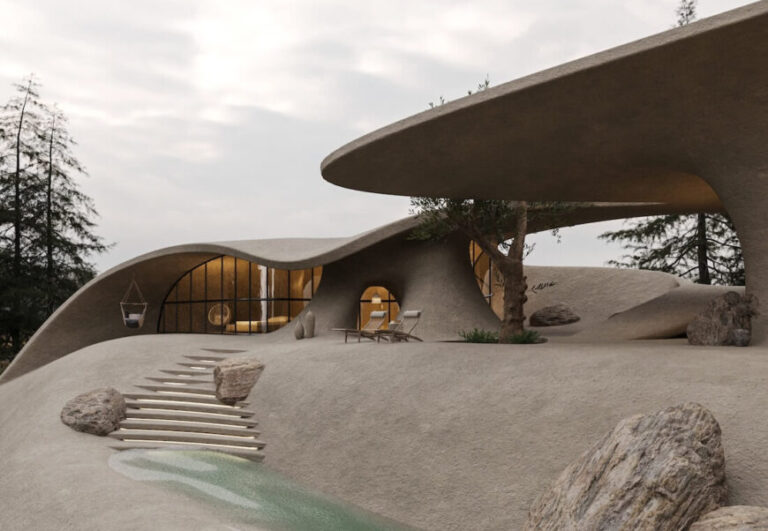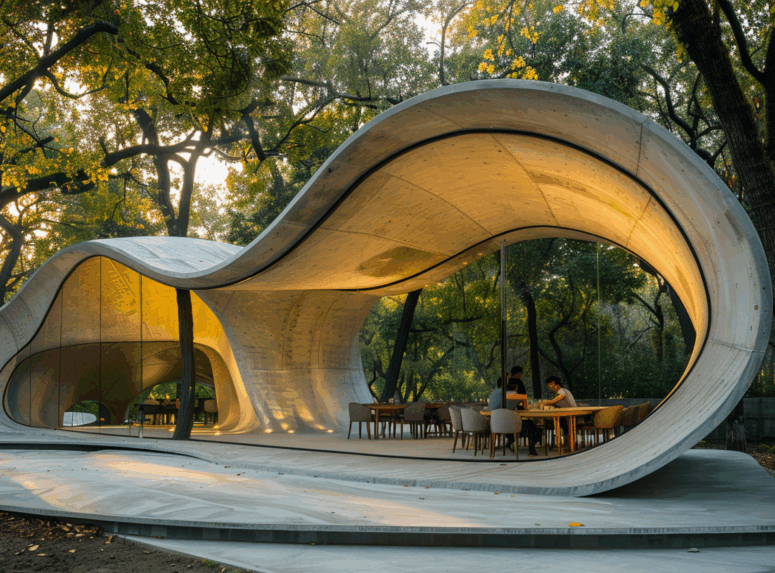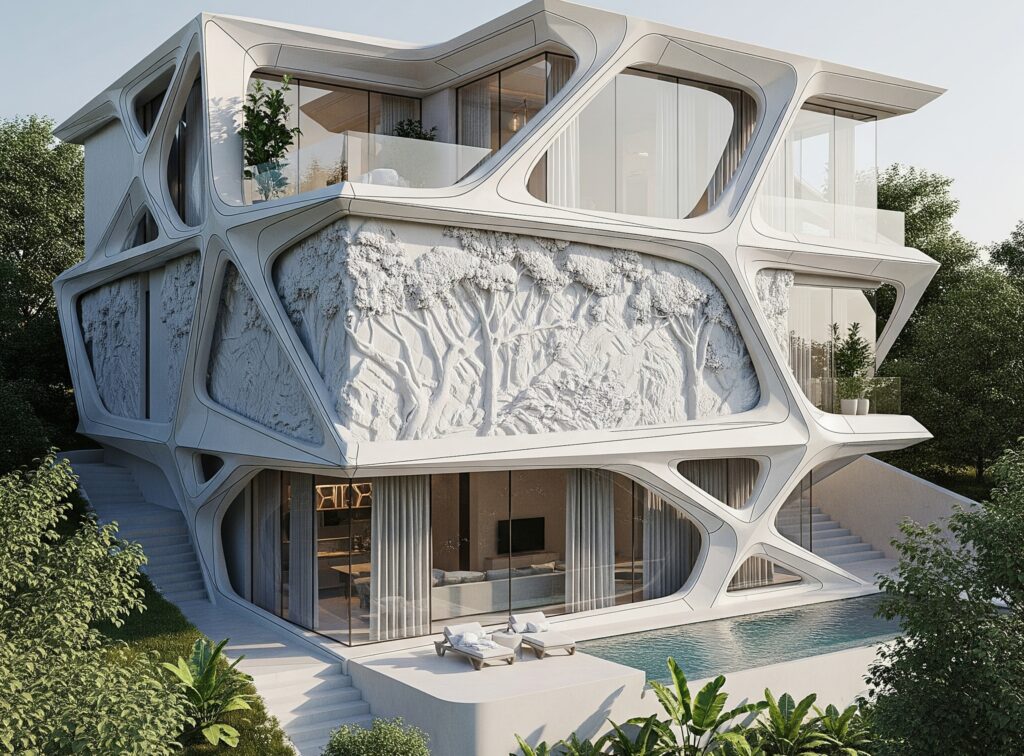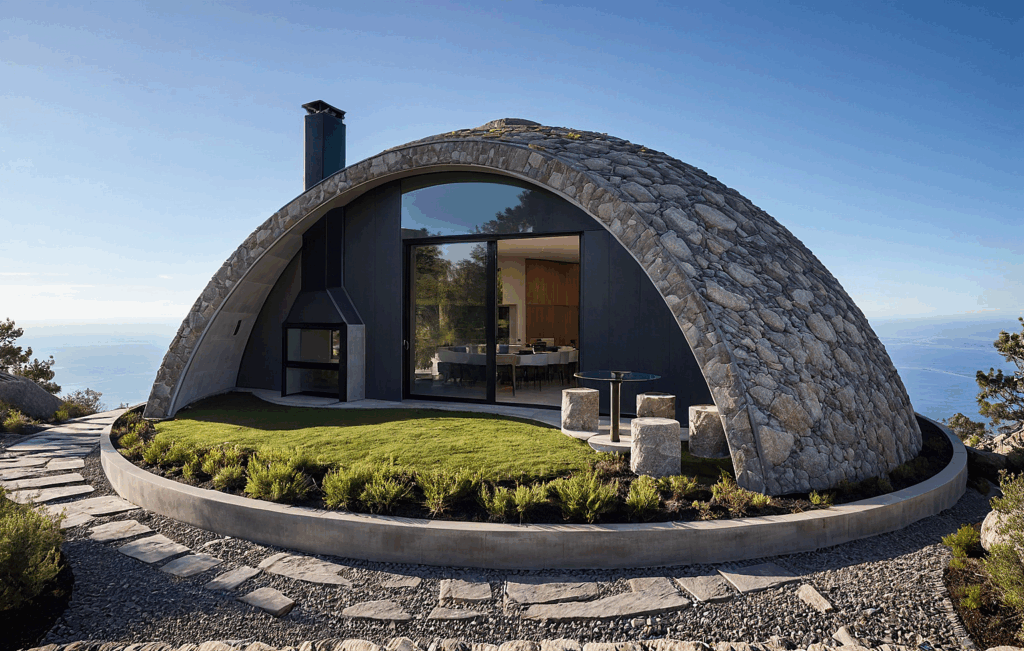Types of finishing:
flexible facade plasters
Elastified plasters are finishing layers of high elasticity and resistance, developed for surfaces with complex geometry. Thanks to their adaptability, they adhere perfectly to curved and organically shaped STIROTON objects - without cracks, expansions or joints.
Due to their resistance to UV radiation, moisture and temperature changes, flexible plasters are ideal for demanding outdoor conditions, but also for interiors where a clean, uninterrupted form is desired.
📍 Example: The “Hidden Haven” House
In this project, flexible plaster was used to allow for a smooth wrapping of architectural curves, without joints or visual interruptions. The material acts like the skin of the building – following it in every direction, without losing its integrity.
Visual effect: a completely smooth, continuous surface that reflects the form of an object.
Technical benefit: exceptional resistance to moisture and ground movements, ideal for natural environments.

Microcement and smooth concrete-look layers
Microcement is a thin, highly adhesive finishing layer that allows the creation of completely smooth, monolithic surfaces. Thanks to its plasticity and strength, it adapts to complex shapes.
Its appearance often resembles polished concrete or smooth stone, making it ideal for projects that want to maintain a minimalist, technically expressive character.
📍 Example: Wave Pavilion
In this pavilion, microcement is applied in a thin layer over the curved surfaces of the structure, creating the impression of a continuous concrete wave. The surface reflects light in gentle gradients, without any joints that would disrupt the form.
Visual effect: sophisticated “concrete” look, soft and contemporary.
Technical benefit: high resistance to moisture and abrasion, long-lasting layer and easy maintenance.

Relief facade treatment
Embossed processing enables the facade to be shaped as a spatial texture - deep, tactile and conceptually related to the architectural idea itself. Each relief is made manually, on the spot, without industrial molds, which allows complete freedom of expression: from abstract patterns and landscape waves, to expressive, sculptural forms.
📍 Example: Villa Aestus
Visual effect: The relief provides three-dimensionality and depth, and the play of light and shadow changes the perception of the facade depending on the time of day and the angle of view. It acts as a sculptural art installation that brings the entire villa to life, blending it with the surrounding natural landscape.
Technical benefit: Handcrafting allows for exceptional customization and precision, although it is more time-intensive. The materials used, such as special plaster and microcement, ensure exceptional durability, resistance to UV radiation, moisture and temperature changes, and minimal maintenance. This type of construction creates a unique facade that is resistant to all external conditions.

Imitation stone/rock
This type of finish does not attempt to literally imitate natural shapes, but rather architecturally reinterpreted through precisely crafted designThe facade thus becomes tactile and visually strong surface, inspired by geological structures, but designed with a clear compositional logic.
The surfaces are hand-modeled, built in layers to create sharply defined transitions, broken surfaces and depth contrasts, which gives the object sculptural expressiveness and material weight.
📍 Example: Terra Domo
On the project Terra Domo, the facade finish is executed in segments that resemble complex stone slabs and blocks. The relief is precisely shaped to emphasize architectural transitions and support the geometry of the building. The form and texture are clearly designed and executed according to a predefined concept.
Visual effect: A facade resembling broken stone surfaces, with pronounced depths and transitions.
Technical benefit: Durable, hand-crafted finish suitable for outdoor conditions and long-lasting visual impact.

GRC (Glassfibre Reinforced Concrete)
GFRC (Glass Fiber Reinforced Concrete) is a fiber-reinforced concrete that enables the production of precise, light, and at the same time durable architectural elements. It is ideal for facades, decorative panels, columns, sinks, counters and other prefabricated elements. Its strength and weather resistance make it the perfect choice for long-lasting, high-quality installations and facades.
📍 Example: Module 5 – Flexible Home
On Module 5, GRC-look finish was used to emphasize the monolithic form of the building. The smooth, neutral facade further emphasizes the house's form transitions and reflects the changes in light throughout the day.
Visual effect: Minimalist and clean surface resembling architectural concrete.
Technical benefit: Direct application to complex geometry without joints and plates; long-lasting and resistant processing.


